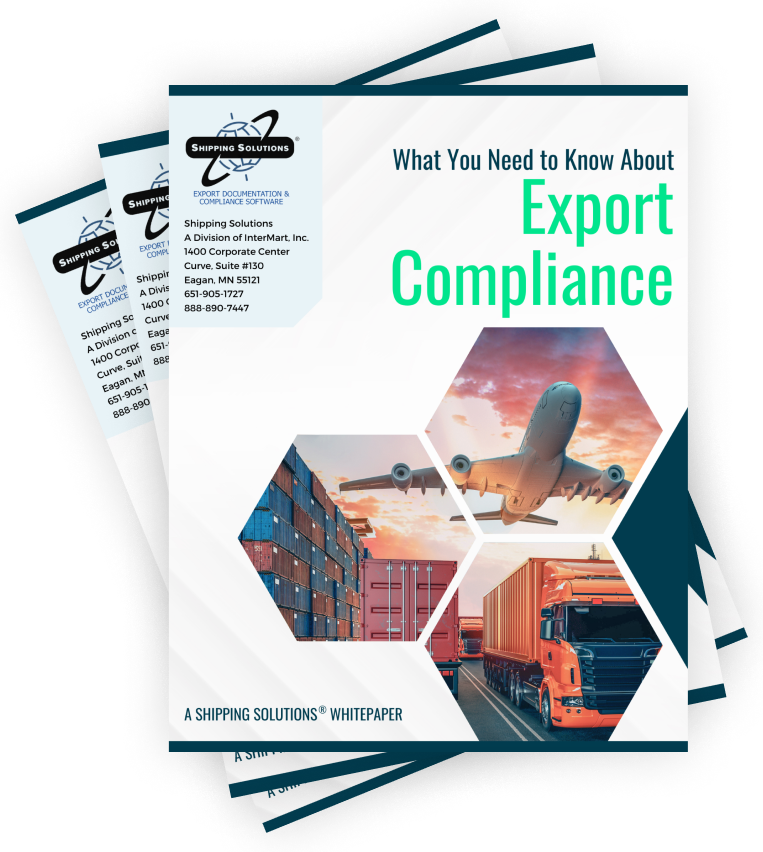The International Trade Blog Export Compliance
EAR99 Isn't a Free Pass for Export Compliance
On: March 14, 2022 | By:  David Noah |
9 min. read
David Noah |
9 min. read
 One of my favorite aspects of working with our customers is getting their feedback about the export processes and systems they use and love. However, there are some instances when I hear things that make me cringe.
One of my favorite aspects of working with our customers is getting their feedback about the export processes and systems they use and love. However, there are some instances when I hear things that make me cringe.
This is especially true when I’m talking to people about export compliance. Too often I hear: “We don’t have to worry about compliance because our items are EAR99.”
Facepalm.
EAR99 doesn’t mean your export compliance worries are done. In fact, determining the proper export control classification for your goods is only part of the compliance process—end use and end user make a difference!
Just look at what is happening in Ukraine right now. The United States and several other countries have increased restrictions on exporting certain types of products to Russia while also imposing sanctions on certain Russian industries, Russian officials and the Russian central bank. Companies must be very careful right now before they export anything to that region of the world even if their products are considered EAR99.
Understanding Export Controls
There isn’t just one regulatory agency that handles export compliance. Instead, there are three primary sets of regulations that control exports: The Foreign Trade Regulations (FTR), Export Administration Regulations (EAR), and International Traffic in Arms Regulations (ITAR). Companies must first identify which regulations apply to their exports and then follow the guidelines they set forth.
(Depending on what you are exporting, there may be other sets of regulations issued by other agencies such as the U.S. Department of Energy that may apply.)
For most exporters, there are some basic steps to take to ensure you are compliant with export regulations. These steps, outlined below, provide companies with a starting point for implementing an export compliance plan. You can read each step in detail in our article Six Basic Steps for Export Compliance.
- Properly classify your products.
- Determine if the destination country requires an export license.
- Screen all parties in your export transaction.
- Watch for Red Flags: know how your product will be used.
- Be aware of deemed exports.
- Document your compliance efforts.
An EAR99 Refresher
The first two steps listed above are used to determine if you need a license to export your products. If your goods fall under the jurisdiction of the Commerce Department’s EAR, and you’ve reviewed the Commerce Control List and determined that your products don’t have an Export Commodity Control Number (ECCN), then they are classified as EAR99.
The Bureau of Industry and Security (BIS), which is part of the Commerce Department, regulates exports under the EAR. According to BIS:
EAR99 is a classification for an item. It indicates that a particular item is subject to the Export Administration Regulations (EAR), but not specifically described by an Export Control Classification Number (ECCN) on the Commerce Control List (CCL). While the classification describes the item, the authorization for shipment of that item may change, depending on the circumstances of the transaction.
NLR stands for the 'No License Required' designation. NLR may be used for either EAR99 items, or items on the CCL that do not require a license for the destination. However, exports of an EAR99 item to an embargoed country, an end-user of concern or in support of a prohibited end-use may require an export license.
That last line is what many less-savvy exporters forget or simply neglect to pay attention to: Even though you’ve determined your goods are EAR99, there are still four steps in the export compliance process listed above that you need to consider.
Restricted Party Screening
The U.S. Departments of Commerce, State and Treasury are just three of the government agencies that publish one or more lists of people, companies and other entities with whom there are restrictions on exporting, reexporting or transferring goods. All told, there are dozens of different lists, called restricted party or denied party lists, and these lists could be updated at any time.
While it’s not a legal requirement to check these lists, it is a violation of export regulations to do business with people or organizations on these lists. Unless you have a very high risk tolerance, you’ll want to check these lists for all your exports.
There are basically three options for screening the parties in your export transactions against these lists:
1. Manually Check the Lists
You could check each of the dozens of different restricted party lists by hand to make sure the person or organization you’re doing business with isn’t on any list, but that’s slow, tedious work. Multiply this process by the number of exports you have, and you’ll see that it’s inefficient to work this way.
2. The International Trade Administration’s Consolidated List
The U.S. International Trade Administration (ITA) publishes a Consolidated Screening List that consists of 10 different lists of denied parties from the Commerce, State and Treasury departments. This is a big step up from manually checking all the restricted party lists from these three departments, and I think it is the bare minimum that companies should do.
While the Consolidated Screening List includes some of the biggest lists published by Commerce, State and Treasury, it does not include them all. Nor does it include the lists published by other U.S. agencies, the many lists published by individual U.S. states, lists from international organizations such as the United Nations, or lists published by other countries. Depending on your company location, where you are doing business, and the types of products you are exporting, these other lists may be relevant to you.
3. Restricted Party Screening Software
A number of companies offer restricted party screening software options that check the lists available in the ITA’s Consolidated Screening List as well as most, if not all the other denied party lists regardless of the size. In addition, their software can automate the process of screening the parties in your export transactions rather than requiring you to manually enter the information into a search engine.
For example, Shipping Solutions Professional export documentation and compliance software allows you to screen all the parties in an export transaction by simply clicking a button. The software uses the information you’ve already entered to create your export paperwork and electronic export information for filing through AESDirect rather than requiring you to reenter all that information once again. Results are immediately displayed onscreen and stored in an audit trail, so you have a record of your restricted party screenings in case you ever get audited by the Office of Export Enforcement (OEE), the FBI or some other agency that has jurisdiction over your exports.
Hundreds of companies use Shipping Solutions Professional software to quickly and easily create accurate export documents while staying compliant with U.S. trade regulations. You can see how the software can help your company stay compliant by requesting a free online demo. There’s no obligation.
Embargoed Countries
In addition to restricting exports to certain people and organizations, the United States has restricted exports to certain destinations without an export license or specific license exception. These restrictions, also known as embargoes, include Cuba, Iran, North Korea and Syria. In addition, there are more nuanced restrictions, such as those in place against certain Russian industries and the Crimean region of Ukraine prior to the more extensive sanctions imposed recently.
Because these restrictions can change, it’s important to periodically check the Treasury Department’s Office of Asset Control (OFAC) website for an updated list of sanctions.
Illegal End Use of Your Products
Even products that seem harmless can sometimes be used in unintended ways. Some end uses are prohibited, and others may require an export license. It is your legal responsibility to know how your products will be used once they leave the country and watch for any red flags that they may be used for illicit purposes.
The Office of Export Enforcement often uses the example of a South African company that placed an order for an unusually large quantity of replacement switches used in medical imaging equipment. The size of the order was a red flag for the U.S. manufacturer, and they promptly notified OEE. Turns out, these switches were intended for use in Improvised Explosive Devices (IEDs) against U.S. troops.
Identifying Red Flags
Red flags are defined by the EAR as “any abnormal circumstances in a transaction that indicate that the export may be destined for an inappropriate end use, end user or destination.” If you have a bad gut feeling, a doubt, or even a question—that’s a sign you need to continue to pull on the thread of suspicion and see what unravels.
BIS has identified the following as red flag indicators, but keep in mind there is no single, complete list of red flags:
- The customer or its address is similar to one of the parties found on the Commerce Department's list of denied persons.
- The customer or purchasing agent is reluctant to offer information about the end use of the item.
- The product's capabilities do not fit the buyer's line of business, such as an order for sophisticated computers for a small bakery.
- The item ordered is incompatible with the technical level of the country to which it is being shipped, such as semiconductor manufacturing equipment being shipped to a country that has no electronics industry.
- The customer is willing to pay cash for a very expensive item when the terms of sale would normally call for financing.
- The customer has little or no business background.
- The customer is unfamiliar with the product's performance characteristics but still wants the product.
- Routine installation, training or maintenance services are declined by the customer.
- Delivery dates are vague, or deliveries are planned for out-of-the-way destinations.
- A freight forwarding firm is listed as the product's final destination.
- The shipping route is abnormal for the product and destination.
- Packaging is inconsistent with the stated method of shipment or destination.
- When questioned, the buyer is evasive and especially unclear about whether the purchased product is for domestic use, for export or for reexport.
Read the article No Bull: Export Compliance Means Watching for Red Flags to find out more about red flags and what you should do if you suspect a red flag with one of your export transactions.
Creating an Export Compliance Program
As you can see, there are a number of steps companies that export need to follow to ensure compliance with U.S. export regulations. That’s why successful export companies usually have a written export compliance program (ECP).
The process of creating an ECP requires company personnel to understand the steps in their export procedures and how those steps relate to current export regulations. It provides a checklist of procedures that should be followed for every export, reducing the likelihood that one of these steps is missed. And it offers an important training tool for new employees.
A written ECP also provides the relevant government agencies proof that your company takes your export controls commitment seriously. In cases where an export violation may have occurred, it may demonstrate that your company is doing its due diligence, and it may serve as a strong mitigating factor from excessive fines or penalties.
Learn More about EAR99
To find more out why EAR99 is not a free pass to avoid licensing your export, check out the following resources:
- Don’t Let This Happen To You!—Published by BIS, this guide includes real-life examples of violations that can occur and penalties that can be assessed. No exporter is too small to be noticed.
- How To Determine If You Need an Export License—In this whitepaper, you’ll learn how to determine whether or not your items require an export license based on the goods’ technical characteristics, the destination, the end user and the end use.
- What You Need to Know about Export Compliance—This whitepaper identifies the steps companies need to follow to ensure they aren’t violating U.S. export regulations and avoid potential penalties.
Like what you read? Subscribe today to the International Trade Blog to get the latest news and tips for exporters and importers delivered to your inbox.
This article was first published in March 2016 and has been updated to include current information, links and formatting.

About the Author: David Noah
As president of Shipping Solutions, I've helped thousands of exporters more efficiently create accurate export documents and stay compliant with import-export regulations. Our Shipping Solutions software eliminates redundant data entry, which allows you to create your export paperwork up to five-times faster than using templates and reduces the chances of making the types of errors that could slow down your shipments and make it more difficult to get paid. I frequently write and speak on export documentation, regulations and compliance issues.



